We did it!
We finally arrived in Santiago after walking for 260km. Over 1500 pilgrims arrived on the same day. We saw many of them crying from spiritual reawakening, religious fervour or just sheer relief to have made it in one piece. For our own arrival, we certainly felt excited, proud, relieved, moved, physically tired and spiritually fresh, but no tears at all, at least not then.
The End of the World
The tears really started to flow when we decided to move on past Santiago to Finisterre, which is literally the end of the world…the Romans could go no further west. This place at the tip of the Western world, symbolised by a 0.00km milestone, is breathtaking, full of positive energy and very moving. Some pilgrims come here to spread their loved ones’ ashes. We didn’t have any ashes but we brought something very meaningful to bury at sea. Before we started the Camino, we found a small tin we inherited from “our” grandmother Mami: in there were a few of her handmade rosquettes (biscuits) which she would offer us every time we visited, and that S could never bring herself to throw in the bin when Mami passed away, so we carried them minus the tin with us on our walk to this point when they were given to the sea with a special song, thanks and a bucket load of tears.
While in Finisterre, we collected our trophies in the form of scallop shells which pilgrims hang from their rucksacks. Most pilgrims buy a polished shell at the start of the Camino, but we really wanted to follow the middle age tradition of finding a shell at the end of the trail as proof that we made it all the way to the end of the world. We in fact had huge fun scavenging the beaches for just the right shells which now swing proudly as we walk. S describes the day: “It is morning and the sun is warm on our skin. The sea is singing its indefatigable song as it breaks on the rocks at the bottom of the cliff on our left, and licks the sandy beach where we walk alone, every so often stooping to pick up a shell among the seaweed and rocks uncovered by the ebbing tide. In looking for our scallop shell, we are re-enacting a very ancient closing ritual, one which traditionally signified reaching the shore, and which today will help us return to our lives after the blessed parenthesis of the past few weeks.”
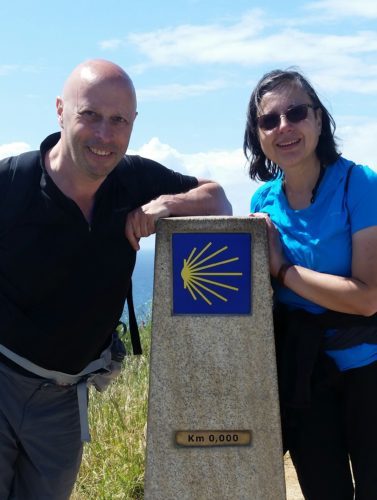


Compostela
During our walk, we collected stamps from hostels, churches, bars and some more unusual places like a coastal police station. All shops and institutions on the trail carry stamps as they entitle pilgrims to collect their Compostela if they make it all the way to Santiago (walkers and cyclists need to collect two stamps per day for the last 100km and 200km respectively). Getting our Compostelas felt so much harder and really more rewarding than earning our university degrees! We were given Latin names on our certificates, Godefridum and Silviam.
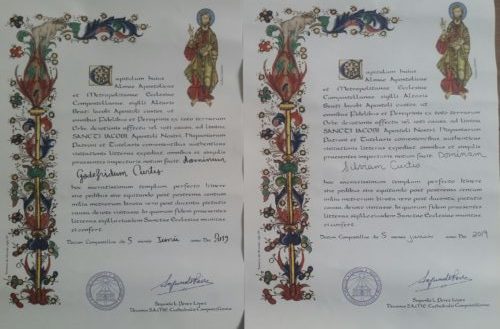
Camino Spirit
Everyone has a private reason for walking the Camino. The pilgrims we met were generally trying to think through problems or searching for a purpose in their lives. On a few occasions, we gave fellow walkers some much needed shoulders to cry on. Some seemed lonely and really needed someone – a sympathetic friendly, older stranger – to listen to them. Being able to simply listen and be listened to made us feel connected and relevant in a way that is difficult to achieve in everyday life. We became ever so close to some, including one young German girl we called our adopted Camino daughter, who will probably join us on our next adventure. We met a charming American couple, Jimi and Maureen, who somehow managed to walk all the way to Santiago with their grown up boys…amazing! We met so many lovely people from all over the world.
For us, we were not really aware of a spiritual or emotional reason to walk the Camino. But it taught us a few things. One overriding beautiful experience was that of community…fellow pilgrims regardless of race, religion and nationality, were always there to support one another, to listen and help in any way they could. We have always had great support from family and friends but have never experienced that level of camaraderie before from strangers. It would be amazing to find it outside of the Camino but we guess that we may need to walk another Camino to find it again.



Food and Drink
We would normally choose a holiday location at least partly on its food and drink…and Portugal and Spain proved no exception. We certainly took advantage of our all time favourite wine, Albariño, which is produced in Galicia, but also discovered the region’s amazing red wine, Ribeira. There are three other terroirs in Galicia to explore next time. Being vegan would have been impossible, and keeping to a vegetarian but dairy free diet was likewise extremely difficult as the concept is not really embraced here. Sometimes, it was simplest to eat the fish and eggs and not live to our normal diet. In any case, vegetarianism as a way of life is not really understood as the meat free salads or vegetable soups we asked for, were often, as tradition demands, garnished with ham! Our favourite dish was the Padron peppers and, as they say in the town, “some are hot, most are not”. They came into season literally days before we entered Padron (the start of June in case anyone plans to visit). These are always fried in olive oil with a generous spattering of salt flakes and are normally eaten with good bread, which is easy to come by throughout the region. Galicia is the country of empanadas of all sorts, including empanada de chocos which often has a maize semolina/polenta like crust and is stuffed with baby squids, and the famous empanada de atùn in all its wonderful varieties. Fried poulpe is a speciality nearly everywhere. Bonus, the padron peppers are never anything other than vegan! Follow them by sea bass washed down with an Albariño and, for dessert, a Tarta de Santiago, and the meal was perfect. Before walking into Galicia from Portugal, despite there being more markets and fruiterers, there were fewer treats on offer, so we tended to opt for the “pilgrim’s menu” which is meant more for sustaining than savouring! It included vegetable soup, bread, grilled fish and sides, dessert, wine and coffee. It was nearly always wholesome and, at €7 to €15, was hard to turn down.
The Beautiful Paths
We have been on more beautiful hikes around the world but none of them had the spirit we encountered here. On our Camino, we had to tread many paths on cobblestones, tarmac and even on busy highways which were either hard on the feet or back or felt dangerous. Even then, interestingly, we saw a sign on many occasions indicating that we were walking on Roman Road XIX. So, despite the tarmac, those parts of the walk still felt historic. The majority of our paths however were beautiful – beaches, eucalyptus forests, vineyards and river walks. Another advantage of the paths was their flatness: we would not have coped in our condition with lots of steep ascents and descents. In fact, this explains why there were quite a number of old pilgrims, some well into their eighties, on this Portuguese Camino. We spent one great day canoeing from Caminha to Valenca to give our weary feet some much needed rest and to exercise our arms and shoulders.
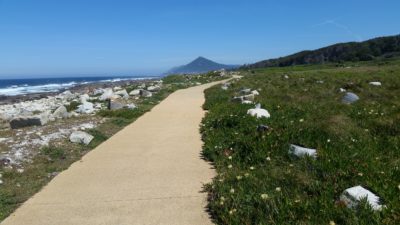
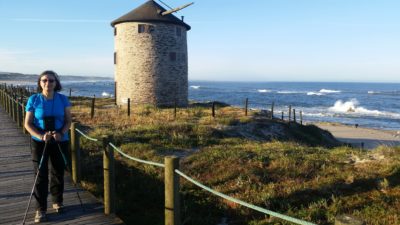




The Towns and Villages
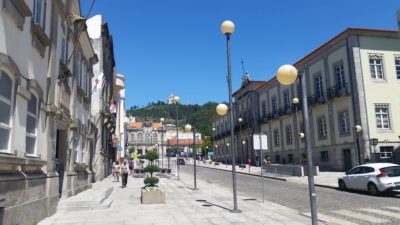
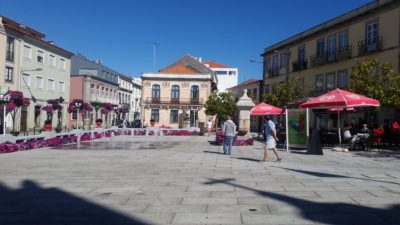
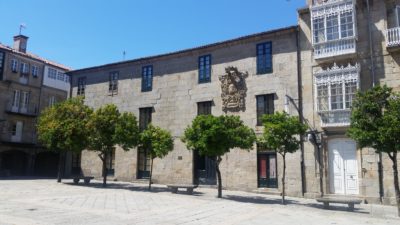
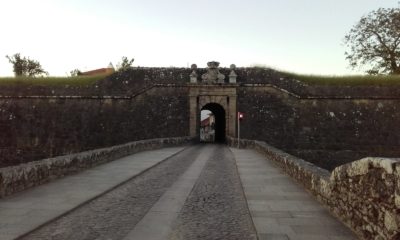
Our favourite town was Pontevedra which was full of medieval squares and had tons of character. We were lucky enough to see a great open air flamenco concert there. Padron was another interesting old town although we were not so lucky to arrive after its famous Sunday market. The city of Valença on the Portuguese side, with its counterpart Tui (just over the bridge into Spain), was also amazing and, completely surrounded by its original wall, reminded us a little of Lucca in Italy.
Churches and History
The Camino was unsurprisingly but interestingly filled with historical monuments and churches. We passed over a bridge made by famous as the scene of a Napoleonic battle and entered into churches mostly from the 16th to 17th Centuries, some of them containing some stunning polychrome wooden statues.
Some more Unusual Sights
We also encountered some very odd sights including a row of coloured birds (surely with artificial colouring?); a town square which commemorated not an historical figure but a duck; delivery boxes in Portugal for bread…some properties which did not have a box had their baguettes strapped to their gates!
Next Up
We would love to walk another Camino next year, maybe a similar route again through Portugal or the Frances or Norte which run along the north of Spain. In the meantime, we are planning to volunteer in India for three months and return to Ethiopia now that we understand better how we can help there. We will also do our fair share of petsitting around Europe starting next week in Brittany…we must visit its Finistère to compare it to the Spanish counterpart.
Postscript: Our Way
Finally some notes which might be useful for those who choose to follow our route…
Portugal Route Spain Route
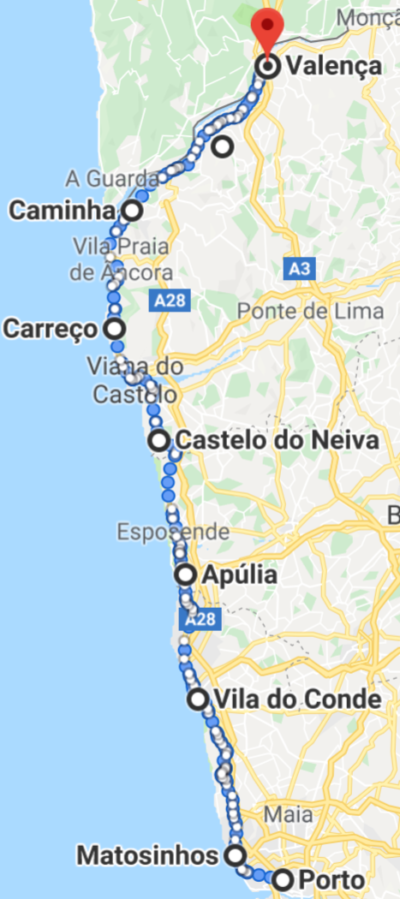
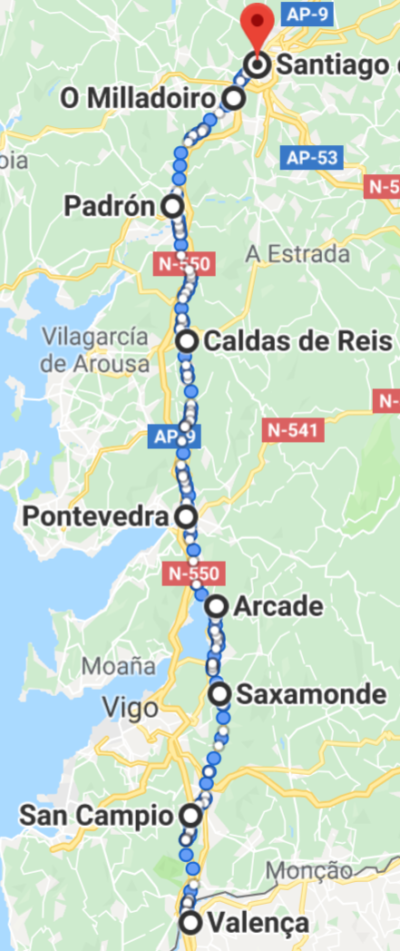
Porto: One of our favourite cities in Europe. There is a lot to see there.
Matosinhos: Porto suburb famous for its fish restaurants, all lined up on one street. Lovely beaches. A place where it would be nice to spend an extra day for the beach, the food and, if needed, to buy anything missing for the walk.
Villa do Conde: Decent Albergue Santa Clara with best pilgrim meal at Ramons where they serve pilgrims with love in their heart. Convent and other interesting sights.
Apulia: Our hotel, Luhu Surf, was on the beach which we had entirely to ourselves. Lovely inn with large garden and facilities for cooking there. Mini fruit and vegetable market, mini supermarket and a very friendly, welcoming little town.
Castelo de Neiva: Nothing so impressive about the town or its albergue. Only fellow pilgrims impressed us here. Town-wise, we wish we had stayed at Viana de Castelo as it is a delightful little town, very friendly, very pretty with some of the best biscuits and cakes of the Camino bought from a welcoming fruit shop and a vast choice of cafes and restaurants.
Carreço: Excellent and beautiful albergue Casa de Sardao with great facilities and horses grazing the garden. The pilgrim meal we had at a restaurant there was memorable for more than one reason. We were very kindly welcomed as pilgrims even though the restaurant was bursting at its seams with a troupe of local country dancers having their last meeting of the year. From where we were sat, we could observe the whole evening as it unfolded. It started with a feast of food and continued with copious but never inebriated toasting, followed by more toasting and singing ending with coffee and football on TV. The food we were served was one of the best, most copious and one of the kindliest service of the whole Camino.
Caminha: Rest day in Porta do Sol Spa Hotel, a far cry from the bunk beds in the albergues. One place where it was difficult to be a dairy free vegetarian as restaurateurs felt quite insulted if you did not eat their seafood and the pasta dishes offered as alternatives were not exactly impressive even if they were freshly made.
Valença: Impressive walled city but filled with tourist shops. The last Portuguese town of this Camino. Reached it by canoeing with caminobyboat.com from Caminha. An exhilarating experience. If you want to do the same, make sure to wear a bathing suit under your quickest drying clothes as there are swimming opportunities in the river when the weather allows and you may get soaked if the weather does not allow. Wear flip flops or similar, long sleeves and take sun protection with you. Also, have a plastic bag for your day necessities. Caminobyboat will transfer your rucksack to Valença.
San Campio: Sits up the hill, off of the Camino route but great time at the one local restaurant – chatted in Spanish all evening, aided by the consumption of a delicious bottle of Albariño with a local couple who invited us back to their home for liqueurs.
Saxamonde: Nothing so impressive about the town or its albergue. Again relied on the camaraderie of pilgrims.
Arcade: Seaside town was pretty dead but had pretty beach and the sea was warm enough to swim in. Just outside the boundary to Arcade was one of our favourite albergue, A Xesteira. Although situated on the main street, it has this huge, very peaceful, beautifully tended gardens with flowers, fruit trees and all manner of seats. It also has one of the better equipped kitchens among albergues, a great bakery nearby with excellent bread and a whole range of empanadas and plenty of supermarkets. We bought the makings of a glorious little meal for two and had dinner under the cherry trees that provided shade, and dessert at a table and benches made of massive granite as the sun set and the fragrance of the flowers enveloped us.
Pontevedra: Favourite small town, great to walk around and admire all the old architecture.
Caldas de Reis: Least favourite town. Will give it a miss next time.
Padron: Favourite meal of the trip at Pulperia Rial, where you learn that Padròn peppers are really cultivated in a nearby place called Hebron. Theirs are really fresh, cooked to perfection with the stems laboriously hand removed with the handle of tea spoon. As with the whole of Galicia, their other speciality is seafood, but their Spanish omelette is likewise delicious. Lovely, with a feeling of balance between tourism and real life. Excellent bakery called San José for bread, cakes and empanadas. The friendly staff their sold us a local bread, the top of which sticks out like a cone. Traditionally, this little cone called Perucho is removed and used as a cup, with the dough replaced by sugar and red wine, which seeps through from the point of the cone.
Milladoiro: Easily the best albergue we stayed at on the whole Camino, particularly as we were 13 occupying a space made for 60. Nevertheless, it is brand new, with a kitchen that is beautiful to look at and beautifully appointed, comfortable common spaces, enough showers and bathroom facilities and separate ones for male and female, good laundry facilities, a room with a computer and printer and its own Netflix. Best of all was the staff…so caring and friendly. Miladoiro, as a suburb of Santiago, is convenient but lacking in beauty or architectural interest.
Santiago: Spectacular city with the 12th Century cathedral portico impressing most of all. Good hostel SCQ made special by its host Jose. Discovered the best Tarta de Santiago, which is sold by nuns in the San Paio de Antealteres convent and produced from their original recipe, which is so superior and different to the mass produced or even panaderia home made versions.
And Finally…
Thanks to all the pilgrims who made our walk so special: Sina, Yasmin, Vikki, Nicole, Yuri, Mika, Kirstine and Maren (Germany), Paolo (Brazil), Yajaira (Peru), See-Yang (South Korea), Gloria and Jose (Spain), Ricardo (Italy), Arushge (Czech Republic), Gary (UK), Rob and Debbie (New Zealand), S (France), Ann-Marie and Sofia (Denmark), Enrique (Cuba), Maria (Portugal), Ans (Holland), Marlen (Belgium). Steve, Carol, Dustin, Joe, Frances, Jimi, Maureen, Sean and Riley (USA).
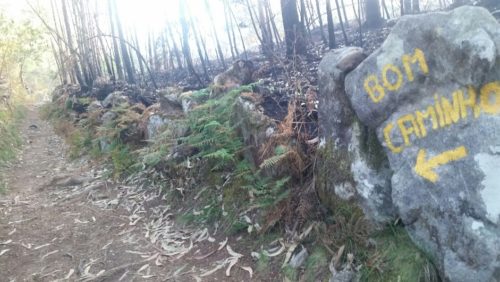
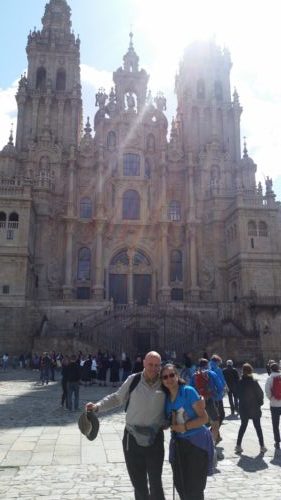
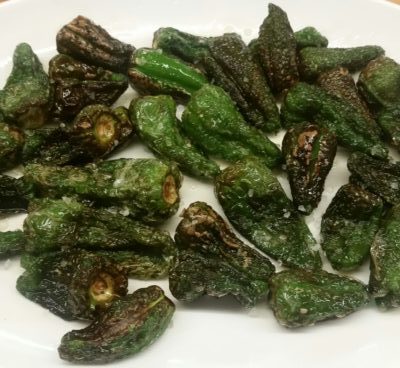
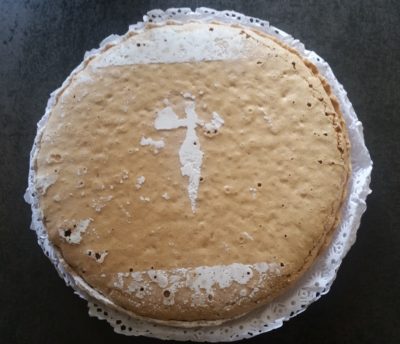


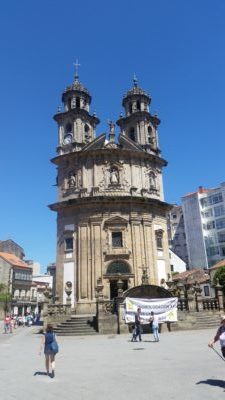
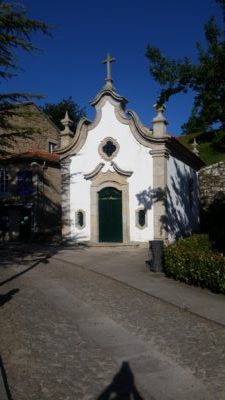
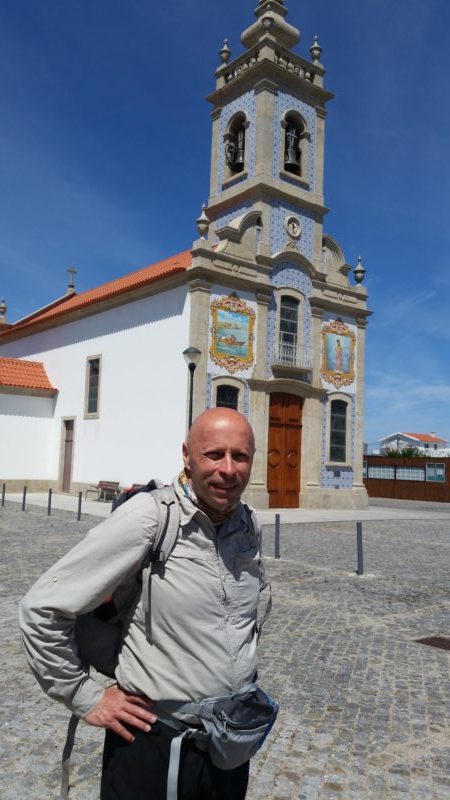
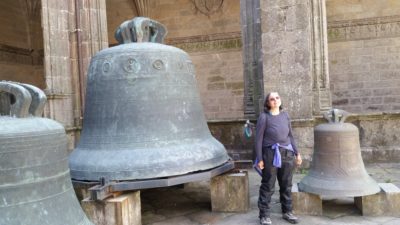
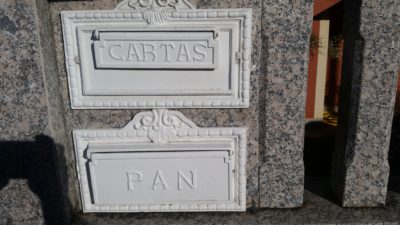
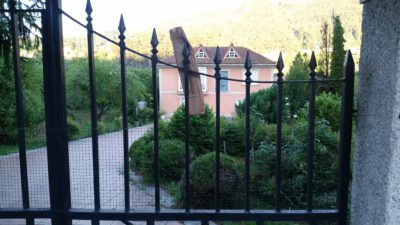
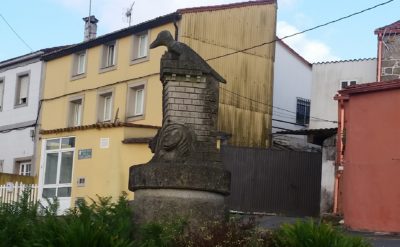
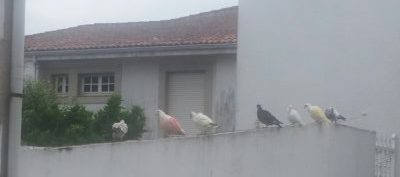
What an amazing journey! Thank you for sharing.
Thank you for sharing.. was a excellent blog to read on a Friday evening….
You are fantastic !! Bravo quel exploit !! Congrats !
Love reading every word. India should be great. Fabulous sites and lovely people.
What a moving and wonderful recount of this incredible journey. Thank you for describing it all so beautifully. I could imagine you both there!
A fascinating travel guide – you are very courageous! Keep going for as long as you can.
Hello Friends,
Happy to see that longer is the trip, youngers the knees are !!!
Congratulation for your strip and it’s very good to have your some news.
Tellement hâte de commencer mon Camino francese … Vous êtes une source d’inspiration inépuisable ❤️